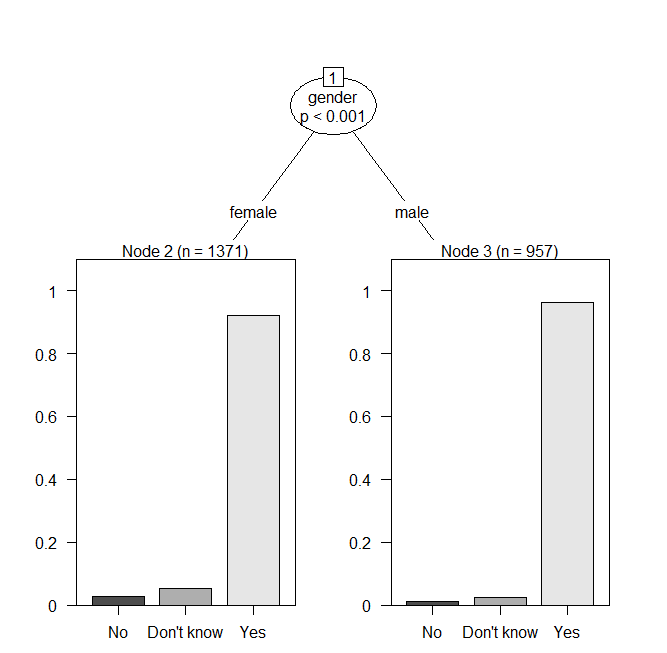I have nominal responses, "yes/no/don't know", that I am using in a conditional inference tree in R. I am having trouble with how to interpret the model's output concerning one of the independent variables: gender. There are other independent variables, like income or education, but the model picks gender as first split even among all independent variables.
A small bit of the data. There are 2328 rows, so I only provided a small number to give an idea of the data:
library(partykit)
dput(head(know_nt))
structure(list(know_nt = structure(c(3L, 3L, 3L, 3L, 3L, 3L), .Label = c("No",
"Don't know", "Yes"), class = "factor"), gender = structure(c(1L,
1L, 2L, 1L, 1L, 1L), .Label = c("female", "male"), class = "factor")), row.names = c(1L,
2L, 3L, 4L, 6L, 7L), class = "data.frame")
know_nt %>% group_by(know_nt, gender) %>% summarize(n())
# A tibble: 6 x 3
# Groups: know_nt [3]
know_nt gender `n()`
<fct> <fct> <int>
1 No female 37
2 No male 12
3 Don't know female 73
4 Don't know male 24
5 Yes female 1261
6 Yes male 921
My model is
ctree(know_nt ~ gender, data= know_nt)
Model formula:
know_nt ~ gender
Fitted party:
[1] root
| [2] gender in female: Yes (n = 1371, err = 8.0%)
| [3] gender in male: Yes (n = 957, err = 3.8%)
I think I am misunderstanding the output. By looking at the plot, where there is a split on male and female, I thought that meant that one gender responded in one way to knowing about nt and the other gender responded in a different way. For example, the male responses selected yes and the female responses selected either no or don't know. But the print of the model says yes for both genders. How is that? How should this be interpreted? If yes is indicative for both genders, why is there a split?


